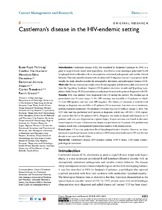Castleman’s disease in the HIV-endemic setting
Date
2018Author
Mahroug, Esam-Rajab
Sher-Locketz, Candice
Abayomi, Emmanuel-Akinola
Tomuleasa, Ciprian
Grewal, Ravnit
Metadata
Show full item recordAbstract
Castleman’s disease (CD), first described by Benjamin Castleman in 1954, is a
giant or angiofollicular lymph node hyperplasia, described as a rare monotypic polyclonal B-cell
lymphoproliferative disorder with an incompletely understood pathogenesis and variable clinical
behavior. This study aimed to determine the incidence of CD diagnosis over an 11-year period. Additionally, the study aimed to describe the demographic, laboratory, and pathological features of CD.
Methods: This is a retrospective study where the demographic and laboratory data were retrieved
from the Tygerberg Academic Hospital (TAH) patient electronic records and Tygerberg Lymphoma Study Group (TLSG) and statistical analysis performed on the patients diagnosed with CD.
Results: Fifty-four patients were diagnosed with CD during this period. The median age at
presentation was 39 years (range: 9–58). HIV serology was available in 53 patients, of which
51 were HIV-positive and two were HIV-negative. The history of initiation of antiretroviral
therapy at diagnosis was available in 43 patients (38 on treatment, four were not on treatment,
and one defaulted treatment). The median CD4 count was 232.50 cells/μL (range: 2–883). The
HIV viral load was performed in 43 patients at diagnosis, which was <49 HIV-1 RNA copies/
μL in more than half of the patients (58%). Diagnosis was made on lymph node biopsies in 53
patients, with one case diagnosed on a spleen biopsy. Kaposi sarcoma was found on the same
tissue biopsy in 13 cases. A bone marrow biopsy was performed in 31 patients. The predominant
features noted were a disorganized hypercellular marrow with plasmocytosis.
Conclusion: CD is a rare polyclonal B-cell lymphoproliferative disorder. However, we demonstrated a significant increase in the incidence of HIV-associated multicentric CD over the last
decade in our area in South Africa.

